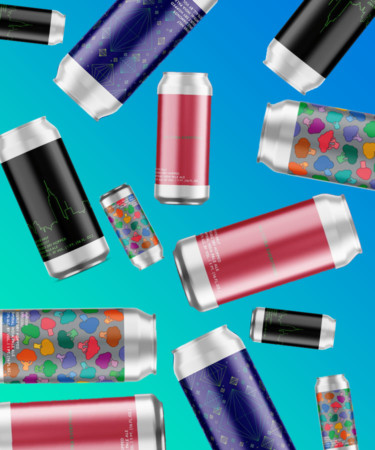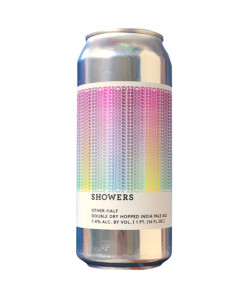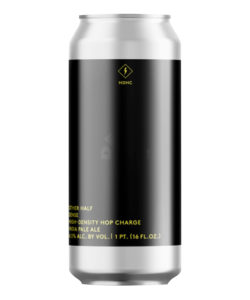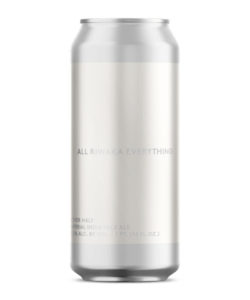This October, VinePair is celebrating our second annual American Beer Month. From beer style basics to unexpected trends (pickle beer, anyone?), to historical deep dives and new developments in package design, expect an exploration of all that’s happening in breweries and taprooms across the United States all month long.
Weekend lines didn’t always snake along the streets of Brooklyn’s Carroll Gardens neighborhood. When Other Half Brewing established its first location in an industrial garage beneath the Gowanus Expressway in 2014, the neighborhood was far from a hub of craft beer activity.
Other Half quickly became known for its bold, “dank,” and fruity, hop-filled IPAs, drawing the attention of beer drinkers in New York. What started as a humble, hop-obsessed hole in the wall transformed into a hopping (pun intended) epicenter of Brooklyn craft beer. Since then, Other Half has grown its following by collaborating with breweries around the world, and grown more locally by opening new locations in New York, Washington, D.C., and Philadelphia. All the while, it has continued to dream up new beers along the way.
Here are 10 things you should know about Other Half Brewing.
Other Half made its brand synonymous with IPA.
Other Half has been known for its IPAs since its first location opened in Brooklyn in 2014. Co-founder and brewmaster Sam Richardson said that he wanted to help give New Yorkers access to bold IPAs like the ones he’d seen on the West Coast. All Green Everything triple IPA was the brewery’s first attempt to do so. The founders saw great success with the beer, as consumers were drawn to the high alcohol content and juicy, hoppy taste. Many New Yorkers hadn’t had a beer quite like it before. By 2016, two years after its founding, 85 percent of the beers it produced at Other Half were IPAs.
While Other Half has since diversified its offerings, it is still primarily famous for this style. The brewery’s IPAs became so popular, in fact, that it had a hard time keeping up with demand. Beers sold out quickly, and the brewers had to focus efforts on increasing and streamlining production. There are still long lines, but brews are more readily available to the masses now.
Other Half made Brooklyn beer famous for a new generation.
According to co-founder Sam Richardson, one of the three founding names behind Other Half, the brewery was preceded only by Brooklyn Brewery, Sixpoint Brewery, and Greenpoint Beer & Ale Co. When Other Half first opened its doors to the public in 2014, it had been nine years since a brewery had opened in the borough. Since then, it has expanded to additional locations in Brooklyn’s Domino Park, New York’s Finger Lakes region, Washington, D.C., and most recently, as of October 2021, Philadelphia.
The head brewer took his love for beer from one half of the U.S. to the other.
Richardson grew up in Portland, Ore., and got his start brewing through Oregon State University’s Fermentation Science Program. He moved to Brooklyn after completing school and began working at Brooklyn’s Greenpoint Beerworks. Here, he met co-founder Matt Monahan, who connected Richardson with Andrew Burnman, and together, the three founded Other Half in 2014.
A Craigslist search helped Other Half find its first space.
Real estate prices were high, so the brewers chose the most affordable option they could find. They landed on Carroll Gardens. This Brooklyn neighborhood, which craft beer enthusiasts now flock to to visit Other Half and a handful of other breweries that have since opened nearby, wasn’t always so desirable. The land sits next to the Gowanus Canal, New York City’s most polluted body of water that has grown increasingly toxic from prolonged industrial activity.
When Other Half’s founders began looking for affordable real estate to house the fledgling brewery concept, Carroll Gardens was undergoing a tentative rebirth. Stores and people were slowly beginning to pop up along the Canal. Other Half found a space in the area on Craigslist, began brewing, and soon drew masses to the neighborhood to try out their beer.
The beer names and labels are made for modern beer drinkers.
Other Half’s branding success can be attributed in part to its talent for creating West Coast-inspired New England IPAs and in part to its unique, attention-grabbing aesthetic. Can labels differ based on the brew, but all have a clean, modern, fun and/or futuristic design. Richardson attributes this in part to the brand’s desire to steer away from more traditional-looking can designs. Bold, scripted type and throwback-style labels reigned in the mid-2010s. Other Half decided to go in the opposite direction using everything from sleek geometric shapes to cartoon vegetables. How’s that for standing out?
Other Half defines dry-hopping.
Hops have been associated with Other Half from the brewery’s start. It made double-dry-hopping, a technique that’s standard fare for any IPA brewer today, a brand by labeling “DDH” on their its coveted 16-ounce cans. So, when a new method started picking up steam in 2020, it only made sense that Other Half had dreamed up the idea a year prior. The method, called high density hop charge (HDHC for short), maximizes hop flavor while minimizing lost beer when brewers use pellets. The method grew so popular among Other Half customers that the brewery unveiled Hops Week in June 2020, when it released six new HDHC brews.
Fanatic thirst made Other Half headline worthy.
If Other Half’s reach had been confined to New York when the brewery started in 2014, it gained a prominent place in the national spotlight by 2017. In early 2017, The New York Times ran an article about customers lining up in front of the storefront 11 hours in advance of Other Half’s new IPA releases. Shortly after, VinePair reported on Other Half fanatics and the growing number of consumers willing to wait in long lines for craft brews.The press further popularized the brewery’s name and built brand recognition at a national level.
Instagram boosted Other Half’s presence from the get-go.
It may not have been Other Half’s goal to amass followers and brand enthusiasts through digital methods, but the brewery quickly hit its stride on social media. Its stylish branding and labels were photographed by professionals, which made for eye-catching social media posts. From these visuals grew a large following. To date, Other Half has over 213,000 followers on Instagram, 41,200 on Facebook, and 22,900 on Twitter.
Wrestlers and brewers are cornerstones of Other Half festivals.
Other Half events are rarely complete without a few wrestlers battling it out inside the ring. The reason? Other Half has hired several wrestlers as employees over the years, and cashes in on the connection by hosting New York Wrestling Connection wrestlers for live matches at its events. Wrestlers frequently make an appearance at the annual Pastrytown festival, which also features food, bakeries, and a variety of pastry stouts from Other Half and other U.S. breweries. Wrestlers even made a virtual appearance at Other Half’s 2020 Green City hops festival.
Aside from the athletic action, Other Half festivals also host craft brewers from across the U.S. Part of Other Half’s company vision is to highlight the importance of local breweries in their communities. Over 50 are coming to Brooklyn to show off their own beer creations at Other Half’s 2021 Pastrytown festival.
Other Half has 1,153 beers to its name — and you can see them all online.
A 97-page swipe through Other Half’s “Our Beers” webpage will leave viewers with all the knowledge they need about the brews Other Half has dreamed up. And it’s dreamed up a lot of them.
There are collabs with other breweries that feature eye-catching names like Intern Backpack and Flip Phone Holster. There are Other Half IPA originals that are available in the brewery’s taproom, like Green City and Mosaic Dream. All past and present beer names, varieties, and other tasting notes are available at the click of a mouse.



